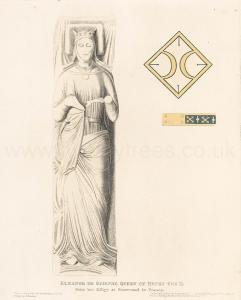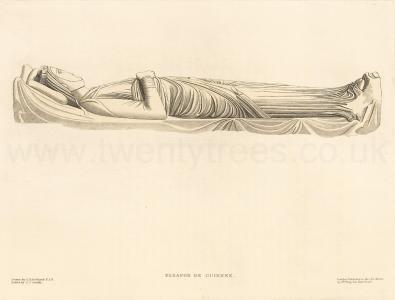Effigy of Eleanor of Aquitaine
Effigy of Eleanor of Aquitaine is in Monumental Effigies of Great Britain.
Eleanor of Aquitaine, or Guienne, was the eldest daughter and heiress of William V. Duke of Aquitaine, by Eleanor of Chastelleraut, his wife. She was first married to Louis VII. of France, but, owing to some dissension which arose between them, Louis applied to the papal see for a divorce: and it appearing that there was consanguinity between the parties, they were separated by authority of the Church in Easter 1151. Henry the Second, then Duke of Normandy, thought that a marriage with the Countess of Poitou and Aquitaine offered too large an accession of dominion and political power to his crown to be neglected, and so promptly took his measures that he espoused her the following Whitsuntide. She bore King Henry six sons and three daughters. Their eldest daughter Matilda married Henry the Lion, Duke of Saxony; among the issue of which marriage was Otho the Fourth, Emperor of Germany, and William, progenitor of the Dukes of Brunswick, who assumed as his arms the two lions which his grandfather Henry bore, and which seem to have been the ensign of the early English Kings of the Norman race as Dukes of Normandy. Eleanor thwarting the amours of her husband, and taking part against him with their elder son Prince Henry (who had received the titular and aspired to the actual honours of King during his father's lifetime), incurred his deep displeasure, and, according to Matthew Paris, banished from his bed, passed sixteen years of her life in close confinement. On the death of Henry in 1189, and the accession of her third son Richard to the Crown, he invested her with sovereign authority during his absence in Normandy; and her first act was a very general release of malefactors from confinement. She accompanied Richard to the Holy Land, died in 1204, the sixth year of the reign of her son John, and was buried at Fontevraud [Map]. She lies, like the other effigies at that place, upon a bier, attired in her royal vestments, with a crown upon her head.


